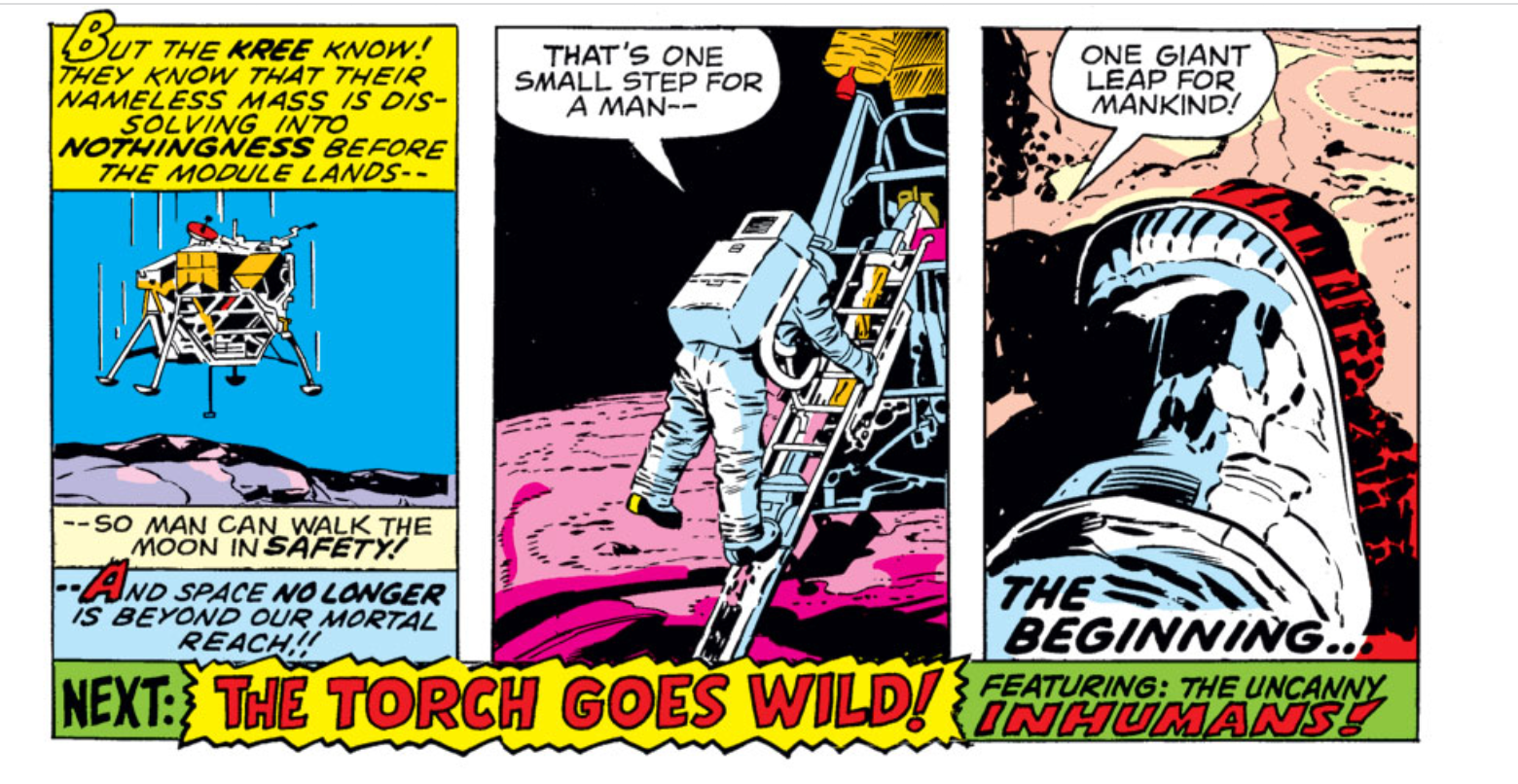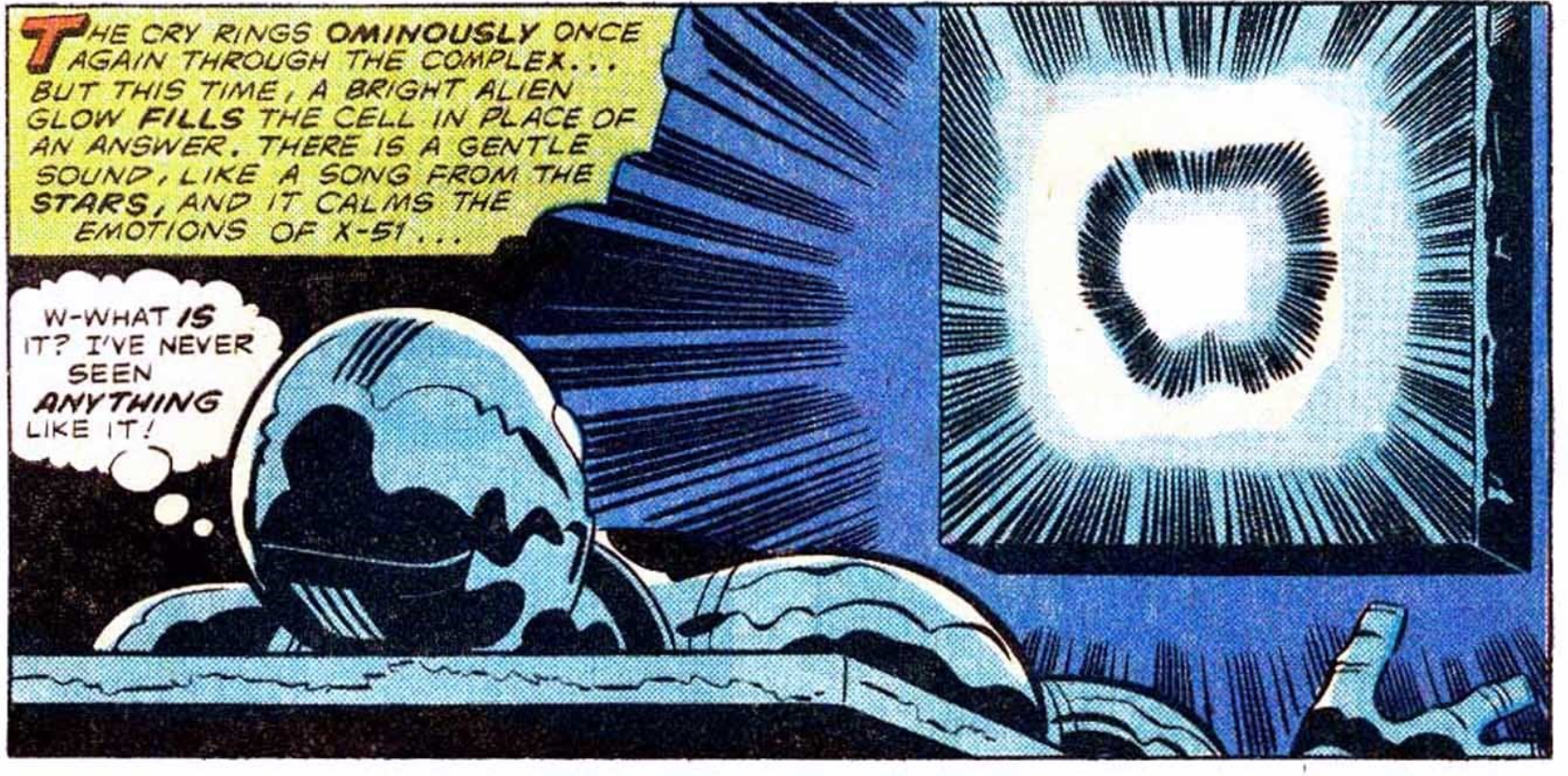One Small Step — Thanks to the FF!!
AND SPACE NO LONGER IS BEYOND OUR MORTAL REACH!!
Fantastic Four, Vol. 1, #98 (May 1970) “Mystery on the Moon”, involves Mr. Fantastic, the Human Torch, and the Thing thwarting the scheme of an evil space robot of the Kree, who is aided by a sinister nameless mass buried beneath the lunar surface, to halt the Apollo 11 moon-landing an evil attempt of space-sabotage: for the Kree have decreed than man shall not conquer space!

What is interesting to me about this quaint but otherwise unexceptional effort from Jack Kirby and Stan Lee, is that the final panels have Neil Armstrong’s famous quote given as originally written (‘one small step for a man’) not as heard (‘one small step for man’).
This comic comes from the days when the comic books written in America were pro-American, and celebrated American accomplishments, and honored our history and our symbols. So I am glad that Jack Kirby got the line right, even if Neil Armstrong did not.
The line is a little hard to hear on the tape, so perhaps Armstrong did not flub it. But, if he did, it is the most famous botched line in history. The nice rhetorical balance is marred, and the gravity and the point of the phrase is lost, if “a man” is not contrasted with “mankind.”
Of course, being comics of the time, the fact that Reed Richards himself, in Fantastic Four Vol.1 #13 (April 1963) “The Red Ghost,” was the first man on the moon is overlooked; Unless evil Russian space-scientist Igor Kragoff were the first man on the moon. Both the Fantastirocket and the transparent spaceship of Kragoff arrived and landed within the same hour, and comic does not show who touched down first.
(Not that it matters. Either Dr. Richard Seaton in the Skylark was the first man to land on the moon in 1926, or Cavor in 1900, unless, of course, Cyrano de Bergerac flew thither in a mechanical locust propelled concussions of gunpowder. I dismiss the account of Lucian of Samosata of being carried to the moon by whirlwind: The superlunary ether admits of no such meteorological disturbances, and we all know well-trained whirlwinds carry travelers to Oz, not Luna.)
Needless to say, in this issue, Neil Armstrong does not meet the enigmatic Watcher, nor does he battle any super-apes in the mysterious blue area of the moon, where an earthlike atmosphere remains, enclosing the ruins of a pre-Adamite lunar civilization.
So the real moonlanding does not fit well into the Marvel continuity — but fanboys need not be so picky! We can accept at least some continuity glitches in reality without any need for a crises! Mr. Fantastic is still thirty-nine years old, even though he fought in World War Two in the OSS, and Ben Grim was a pilot in the Pacific Theater! The exposure to cosmic rays merely made their something something unstable molecules something! All explained!
Astronauts do not discover the enigmatic monolith buried in Tycho crater in the Marvel comic version of 2001: A Space Odyssey #1 (Dec 1976). Instead the enigmatic monolith saves an astronaut named Decker from certain death after a space-crash onto an asteroid between Mars and Jupiter, and transforms him from man to superhuman “star child”.

Later, in issue #8, this same enigmatic monolith finds the experimental military robot X-51, and saves him from the fate that afflicted all other robots in the program (who suffered mental breakdown due to identity crisis) by granting him sanity — or perhaps a living soul. The living robot thereafter is known as “Mr. Machine” or “Machine Man” and is the only element from Jack Kirby’s short-lived venture into the universe of Arthur C. Clarke and Stanley Kubrick to survive into the main Marvel continuity.
For my money, the Jack Kirby version, while sillier, is simpler and clearer and better than the psychedelic lightshow ending of the movie version.
Whether the monolith is itself an tool or agent sent by the Celestials to evolve mankind on earth from ape-man to man, and create subspecies of Deviants and Eternals, and whether the Watchers are a race commanded by the Celestials to watch the progress of such experiments on many worlds, is nowhere explicitly stated.
However, in both the case of The Watcher in Fantastic Four Vol.1 #13 and in the novel version of 2001: A Space Odyssey, man’s exploration of the moon is noted by the cosmic powers of outer space, and reveals man not to be alone.
Like 2001: A Space Odyssey, Jack Kirby’s The Eternals was meant originally to be separate from the main continuity of the Marvel universe. The conceit that the superhuman figures remembered as pagan gods worshipped by our ancestors were, in fact, an immortal and psionic subspecies of man created by extraterrestrial genetic tampering, is a conceit that makes no sense if (as in the main continuity) the gods of Olympus and Valhalla are real.
To their credit, after colliding the two incompatible storylines into the same background universe, later issues do gallantly attempt to reconcile them by having Zeus and Zuras, due to their physical resemblance, form an alliance where the Eternals would represent the Olympians on Earth.
In the original, the Deviants were a race of shorter-lived humans whose mutation rate was higher than human, and the Eternals were long-lived humans whose mutation rate was zero, because they never died. As the Eternals form the basis of human myths of gods and demigods, so too the Deviants form the basis of myths of trolls and devils and other monsters. At several places in the original comic, the Eternals are explicitly said to be unkillable by any means: even if burned to ash, the ashes would regather and reconstitute.
The enigmatic Celestials are the “ancient astronauts” of Van Daaniken, here given the same role as the monolith of Arthur C. Clarke: to give a secular and extraterrestrial origin for the dawn of man. (Whereas we all know that man was placed in Eden by the time-traveling sorcerer from the 31st century, Sise-Neg, after defeating the monstrous devil-god Shuma Gorath.)
The main plot of the original comic book run of the Eternals was the hope and menace posed by the return of the Celestials, and the judgment day to result, as they were to decided which subspecies, Deviant, Man or Eternal, to promote and which to wipe out — if that were the matter of the judgement, which is deliberately left unclear. The prior visit resulted in the sinking of Atlantis, and the banishment of the Deviants to an underground realm.
If my guesswork of the various cosmic enigmas involved were correct, the main theme in the original run of the comic was that the Deviants wanted to survive the coming Celestial judgment day, and so were secretly manipulating mankind into self-destructive paths, so that the Celestials would condemn man, and Deviant would inherent the earth. Meanwhile, because they did not want to be worshipped by Man, the Eternal acted with equal secrecy, but were aiding mankind’s development, for they regarded the coming judgment would be based on their ability to cooperate with other branches of the human species, rather than compete.
During the Kree-Skrull war, it is later revealed that the Celestials had visited many worlds in the countless ages, and that the shape-changing Skrulls were the Deviants of their world who had prevailed there; and the rigid Kree were the Eternals of their world, locked into a state of static perfection.
From what I hear about the movie, these plot elements have been changed: the Eternals, despite the name, can be killed.
Nor are they psionic-evolved eternal humans, but instead are artificial androids; the Deviants are merely monsters, created by mistake, not deviant-evolved human mutations; and the Celestials mean to destroy the earth in order to give birth to one of their own.
I have heard that this film fits only awkwardly into the main continuity of the Marvel Cinematic Universe, with some sort of prime directive to explain why the Eternals, while guiding mankind’s progress, did not interfere with Ultron or Thanos: but since the original comic fit only awkwardly into the main Marvel continuity, I utter no criticism on this point.
But I do criticize that the main hero in the comic, Ike Harris, aka Ikaris the Eternal, in the flick is the main villain. It is an act of unwelcome plot-twist akin to making the Skrulls the innocent victims rather than the alien invaders in the unwatchable Ms. Marvel movie; less a plot twist and more twisting the head of a chicken.
Ikaris is evil precisely because he is aiding the Eternals who created him in the task for which he was created.
The Eternals are merely shepherds fattening humans for the slaughter, and have aided in many genocides in many worlds in eons past, but are mind-wiped and implanted with false memories after each act of worldwide slaughter.
The Celestials, despite their transinfinite hyper-ultracosmic powers, apparently have not discovered a reproductive strategy above the level of a digger wasp. They are the aliens from ALIENS but enlarged to Galactus. What Galactus needs for breakfast, the Eternals need for their incubator, with the Eternals in the role of the Silver Surfer.
I cannot but be annoyed: the movie apparently abandons the eerie cosmic-level ideas of the Jack Kirby concerning the Celestials, only to replace them with an inferior version of eerie cosmic-level ideas of the Jack Kirby concerning Galactus the planet-eater. If what I have heard of the film is true, the whole concept of Celestials-as-Galactus is saved from mere folderol by having the Celestials be part of the cosmic cycle of creation and destruction: if new Celestials are not born, no new worlds will know life.
Unlike the real Celestials of Jack Kirby, the flick version of these incomprehensible ulterior beings are prone to make mistakes. They mistreat and abuse their servants. They design and build their android super-warlords to be deaf, or fat, or arrested forever at preadolescent development, or afflicted with same-sex attraction disorder. Why android being would have sexual attraction, if they do not reproduce, is not explained.
This not only upends the whole concept, eliminating the evolution theme, the ancient astronauts theme, and the Last Judgement theme, but its renders the whole, characters and setting both, into something bland and foolish, not to mention turning the good guys into participants in mass murder.
I was not planning to see the movie in any case. I have been warned by wise voices not to give money to people who hate me.
The days when superheroes stood for Truth, Justice, and the American Way, or would have celebrated patriotism, motherhood, marriage, or anything normal or decent is long past. The inability of postmodern posthumans to grasp human emotions, orient a human moral compass, or to portray heroism in any shape, prevents posthuman movies from being movies, stories from being stories. What the “woke” glorify themselves for waking from is the thing called reality.
That is a topic for another day. For now, let us remember the achievements of the Space Age, and wait in hopeful joy that, once the “woke” are condemned by the Celestials as deviant and evolution dead ends, we humans can continue the real Space Race, which was never against the Russians, not really, but was always against the challenge of overcoming our own sloth and confusion.
God has created wonders in the universe. If we are meant to go behold them, let us do so.
The second small step for a man, or a giant leap for mankind, is waiting.
